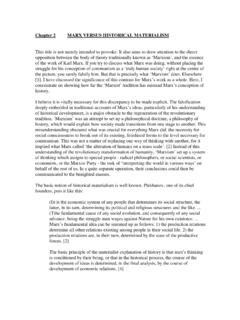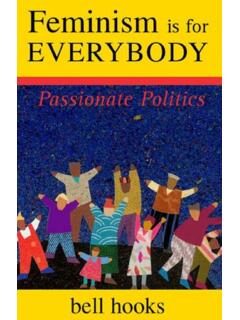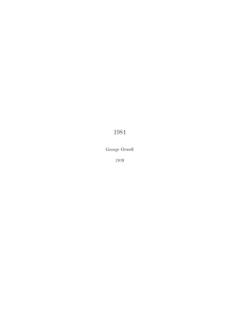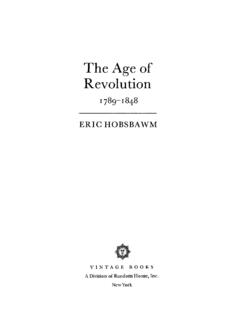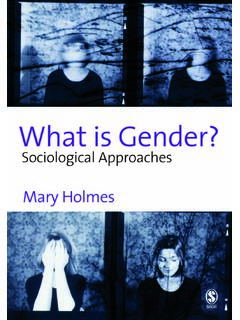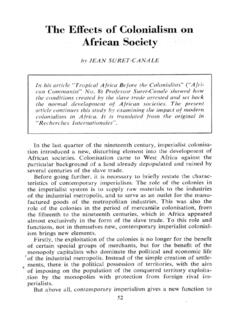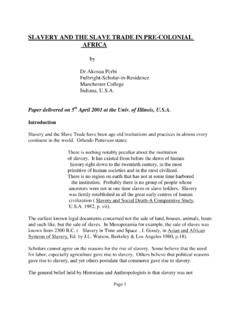Transcription of This book made available by the Internet Archive.
1 This book made available by the Internet G. & E. L. ELBERT r vtsnxiHihtntn $S&4- JL3 oILIA SMITE JELBERT l8aJkx MmmvxitmKkTEkRim B. COMAITBLACK RECONSTRUCTION IN AMERICAby the same authorDARKWATER '.VOICES FROM WITHIN THE VEILDARK PRINCESSAd Virginiam Vitae SalvatoremDigitized by the Internet Archive in 2013 THE READERThe story of transplanting millions of Africans to the new world, and of their bondage for fourcenturies, is a fascinating one. Particularly interesting for students of human culture is thesudden freeing of these black folk in the Nineteenth Century and the attempt, through them,to reconstruct the basis of American democracy from book seeks to tell and interpret these twenty years of fateful history with especialreference to the efforts and experiences of the Negroes the opportunity of making this study, I have to thank the Trustees of the RosenwaldFund, who made me a grant covering two years; the Directors of the National Association forthe Advancement of Colored People, who allowed me time for the writing; the President ofAtlanta University, who gave me help and asylum during the completion of the work.
2 And theTrustees of the Carnegie Fund who contributed toward the finishing of the manuscript. Ineed hardly add that none of these persons are in any way responsible for the views would be only fair to the reader to say frankly in advance that the attitude of any persontoward this story will be distinctly influenced by his theories of the Negro race. If he believesthat the Negro in America and in general is an average and ordinary human being, who undergiven environment develops like other human beings, then he will read this story and judge itby the facts adduced. If, however, he regards the Negro as a distinctly inferior creation, whocan never successfully take part in modern civilization and whose emancipation andenfranchisement were gestures against nature, then he will need something more than thesort of facts that I have set down.
3 But this latter person, I am not trying to convince. I amsimply pointing out these two points of view, so obvious to Americans, and then withoutfurther ado, I am assuming the truth of the first. In fine, I am going to tell this story asthough Negroes were ordinary human beings, realizing that this attitude will from the firstseriously curtail my E. BURGHARDT DU BOISA tlanta, December, 1934 BLACK RECONSTRUCTION IN AMERICAI. THE BLACK WORKERHow black men, coming to America in the sixteenth, seventeenth, eighteenth and nineteenthcenturies, became a central thread in the history of the United States, at once a challenge toits democracy and always an important part of its economic history andsocial developmentEasily the most dramatic episode in American history was the sudden move to free fourmillion black slaves in an effort to stop a great civil war, to end forty years of bittercontroversy, and to appease the moral sense of the day of its birth, the anomaly of slavery plagued a nation which asserted the equalityof all men, and sought to derive powers of government from the consent of the sound of the voices of those who said this lived more than half a million black slaves.
4 Forming nearly one-fifth of the population of a new black population at the time of the first census had risen to three-quarters of a million,and there were over a million at the beginning of the nineteenth century. Before 1830, theblacks had passed the two million mark, helped by the increased importations just before1808, and the illicit smuggling up until 1820. By their own reproduction, the Negroes reached3,638,808 in 1850, and before the Civil War, stood at 4,441,830. They were 10% of the wholepopulation of the nation in 1700, 22% in 1750, in 1800 and in workers were not all black and not all Africans and not all slaves. In i860, at least 90%were born in the United States, 13% were visibly of white as well as Negro descent andactually more than one-fourth were probably of white, Indian and Negro blood.
5 In i860, 11%of these dark folk were free origin, the slaves represented everything African, although most of them originated on ornear the west Coast. Yet among them appeared the great Bantu tribes from Sierra Leone toSouth Africa; the Sudanese, straight across the center of the continent, from the Atlantic tothe Valley of the Nile; the Nilotic Negroes and the black and brown Hamites, allied withEgypt; the tribes of the great lakes; the Pygmies and the Hottentots; and in addition to these,distinct traces of both Berber and Arab blood. There is no doubt of the presence of all thesevarious elements in the mass of 10,000,000 or more Negroestransported from Africa to the various Americas, from the fifteenth to the of them that came to the continent went through west Indian tutelage, and thus finallyappeared in the United States.
6 They brought with them their religion and rhythmic song, andsome traces of their art and tribal customs. And after a lapse of two and one-half centuries,the Negroes became a settled working population, speaking English or French, professingChristianity, and used principally in agricultural toil. Moreover, they so mingled their bloodwith white and red America that today less than 25% of the Negro Americans are of unmixedAfrican long as slavery was a matter of race and color, it made the conscience of the nation uneasyand continually affronted its ideals. The men who wrote the Constitution sought by everyevasion, and almost by subterfuge, to keep recognition of slavery out of the basic form of thenew government. They founded their hopes on the prohibition of the slave trade , being surethat without continual additions from abroad, this tropical people would not long survive,and thus the problem of slavery would disappear in death.
7 They miscalculated, or did notforesee the changing economic world. It might be more profitable in the west Indies to killthe slaves by overwork and import cheap Africans; but in America without a slave trade , itpaid to conserve the slave and let him multiply. When, therefore, manifestly the Negroeswere not dying out, there came quite naturally new excuses and explanations. It was a matterof social condition. Gradually these people would be free; but freedom could only come to thebulk as the freed were transplanted to their own land and country, since the living together ofblack and white in America was unthinkable. So again the nation waited, and its consciencesank to in a rich and eager land, wealth and work multiplied. They twisted new and intricatepatterns around the earth.
8 Slowly but mightily these black workers were integrated intomodern industry. On free and fertile land Americans raised, not simply sugar as a cheapsweetening, rice for food and tobacco as a new and tickling luxury; but they began to grow afiber that clothed the masses of a ragged world. Cotton grew so swiftly that the 9,000 bales ofcotton which the new nation scarcely noticed in 1791 became 79,000 in 1800; and with thisincrease, walked economic revolution in a dozen different lines. The cotton crop reached one-half million bales in 1822, a million bales in 1831, two million in 1840, three million in 1852,and in the year of secession, stood at the then enormous total of five million facts and others, coupled with the increase of the slaves to which they were related asboth cause and effect, meant a newworld; and all the more so because with increase in American cotton and Negro slaves, cameboth by chance and ingenuity new miracles for manufacturing, and particularly for thespinning and weaving of giant forces of water and of steam were harnessed to do the world's work, and the blackworkers of America bent at the bottom of a growing pyramid of commerce and industry.
9 Andthey not only could not be spared, if this new economic organization was to expand, butrather they became the cause of new political demands and alignments, of new dreams ofpower and visions of of all, their work called for widening stretches of new, rich, black soil in Florida, inLouisiana, in Mexico; even in Kansas. This land, added to cheap labor, and labor easilyregulated and distributed, made profits so high that a whole system of culture arose in theSouth, with a new leisure and social philosophy. Black labor became the foundation stone notonly of the Southern social structure, but of Northern manufacture and commerce, of theEnglish factory system, of European commerce, of buying and selling on a world-wide scale;new cities were built on the results of black labor, and a new labor problem, involving allwhite labor, arose both in Europe and , the old difficulties and paradoxes appeared in new dress.
10 It became easy to say andeasier to prove that these black men were not men in the sense that white men were, andcould never be, in the same sense, free. Their slavery was a matter of both race and socialcondition, but the condition was limited and determined by race. They were congenital wardsand children, to be well-treated and cared for, but far happier and safer here than in their ownland. As the Richmond, Virginia, Examiner put it in 1854:"Let us not bother our brains about what Providence intends to do with our Negroes in thedistant future, but glory in and profit to the utmost by what He has done for them intransplanting them here, and setting them to work on our plantations.. True philanthropyto the Negro, begins, like charity, at home; and if Southern men would act as if the canopy ofheaven were inscribed with a covenant, in letters of fire, that the Negro is here, and hereforever; is our property, and ours forever.
